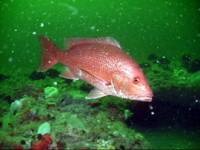 Lutjanus campechanus, the red snapper, is a species of snapper native to the western Atlantic Ocean including the Gulf of Mexico where it inhabits environments associated with reefs. This species is commercially important and is also sought out as a game fish. The red snapper's body is very similar in shape to other snappers, such as the mangrove snapper, mutton snapper, lane snapper, and dog snapper. All feature a sloped profile, medium-to-large scales, a spiny dorsal fin, and a laterally compressed body. Red snapper have short, sharp, needle-like teeth, but they lack the prominent upper canine teeth found on the mutton, dog, and mangrove snappers. The red snapper reaches maturity at a length of about 39 centimetres (15 in). The common adult length is 60 centimetres (24 in) but may reach 100 centimetres (39 in). The maximum published weight is 22.8 kilograms (50 lb), and the oldest reported age is 57 years. Coloration of the red snapper is light red, with more intense pigment on the back. The red snapper is found in the Gulf of Mexico and the southeastern Atlantic coast of the United States and much less commonly northward as far as Massachusetts. In Latin American Spanish, it is known as huachinango or pargo. This species commonly inhabits waters from 30–200 ft (9.1–61.0 m), but can be caught as deep as 300 ft (91 m) on occasion. They stay relatively close to the bottom, and inhabit rocky bottoms, ledges, ridges, and artificial reefs, including offshore oil rigs and shipwrecks. Like most other snappers, red snappers are gregarious and will form large schools around wrecks and reefs. These schools are usually made up of fish of very similar size.
Lutjanus campechanus, the red snapper, is a species of snapper native to the western Atlantic Ocean including the Gulf of Mexico where it inhabits environments associated with reefs. This species is commercially important and is also sought out as a game fish. The red snapper's body is very similar in shape to other snappers, such as the mangrove snapper, mutton snapper, lane snapper, and dog snapper. All feature a sloped profile, medium-to-large scales, a spiny dorsal fin, and a laterally compressed body. Red snapper have short, sharp, needle-like teeth, but they lack the prominent upper canine teeth found on the mutton, dog, and mangrove snappers. The red snapper reaches maturity at a length of about 39 centimetres (15 in). The common adult length is 60 centimetres (24 in) but may reach 100 centimetres (39 in). The maximum published weight is 22.8 kilograms (50 lb), and the oldest reported age is 57 years. Coloration of the red snapper is light red, with more intense pigment on the back. The red snapper is found in the Gulf of Mexico and the southeastern Atlantic coast of the United States and much less commonly northward as far as Massachusetts. In Latin American Spanish, it is known as huachinango or pargo. This species commonly inhabits waters from 30–200 ft (9.1–61.0 m), but can be caught as deep as 300 ft (91 m) on occasion. They stay relatively close to the bottom, and inhabit rocky bottoms, ledges, ridges, and artificial reefs, including offshore oil rigs and shipwrecks. Like most other snappers, red snappers are gregarious and will form large schools around wrecks and reefs. These schools are usually made up of fish of very similar size.
